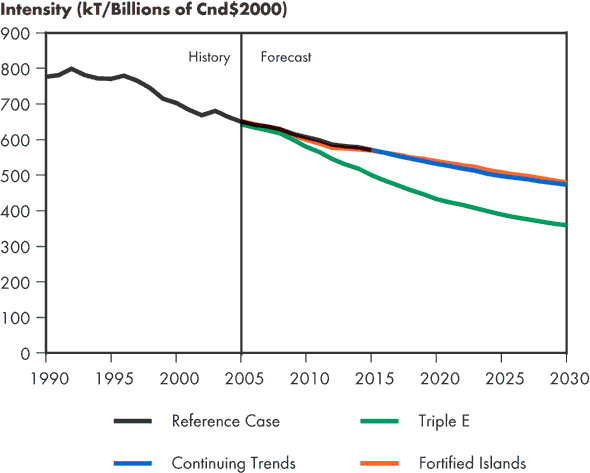ARCHIVED - Fact Sheet - Canada's Energy Future: Reference Case and Scenarios to 2030 - Greenhouse Gas Highlights
This page has been archived on the Web
Information identified as archived is provided for reference, research or recordkeeping purposes. It is not subject to the Government of Canada Web Standards and has not been altered or updated since it was archived. Please contact us to request a format other than those available.
Fact Sheet - Canada's Energy Future: Reference Case and Scenarios to 2030 - Greenhouse Gas Highlights
There is growing debate in Canada over the future of Canada's energy resources and our environment. A major issue in the discussion are greenhouse gas (GHG) emissions because of their role in climate change. Addressing this issue requires early action and use of all the strategies at our disposal.
1. Controlling GHG emissions will be challenging.
In the scenarios outlined growth in emissions ranges from -0.1 to 1.5 per cent, per year. Emissions increase in both the Continuing Trends and Fortified Islands scenarios because of continued economic and energy demand growth. In the Triple E scenario, GHG emissions decline slightly because of energy demand management programs.
Achieving the Canadian government's target of 20 per cent reduction in GHG emissions by 2020 would require the consideration of the full spectrum of GHG reduction strategies. As this report focuses on solutions that are specific to Canadian energy markets and associated GHG emissions, many of the strategies for reducing emissions, such as those found in agriculture, forestry carbon sinks and international emissions trading were not considered.
More ambitious programs that will encourage a reduction in energy use, fuel switching, as well as Canadians making different lifestyle choices, will be required to further reduce GHG emissions.
2. Overall GHG emission intensity is declining.
This means there are fewer GHG emissions emitted in the production of the same amount of goods and services in the Canadian economy. In each scenario, the rate of decline differs depending on the policies and programs that are in place.
Canadian GHG Emissions Intensity

The greatest decline is found in the Triple E scenario which declines at a rate of 2.3 per cent, per year compared to the historical rate which is 1.1 per cent, per year. The decline is the result of energy demand management programs, an increase in the use of alternative energy and the implementation of carbon sequestration measures.
In both the Continuing Trends and the Fortified Islands scenario, the intensity declines at a rate of 1.3 per cent, per year. Energy efficiency improvements are being used as well as an increase in alternative energy.
There is a link between economic growth, energy demand and GHG emissions. In order to break this connection, new technology solutions are needed. Although GHG emission intensity is improving, there is still room for further progress.
3. Uncertainty exists over how consumers and technology will respond to energy programs and policies.
Energy demand management and GHG emission programs and policies may impact Canadians lifestyle choices but to what degree cannot be clearly determined.
More rapid progression of technology than assumed in this report or a higher willingness of consumers and industry to make significant lifestyle and production changes would result in a more aggressive GHG emission reduction profile than reflected in the analysis.
Conclusion
Controlling our GHG emissions will be challenging. In order for Canada to achieve the goal set for 2020, important and fundamental changes in the way we live and the way we produce goods and services needs to take place. This includes policies and programs at the federal and provincial levels to reduce GHG emissions as well as a willingness by Canadians to accept these changes.
- Date modified:
